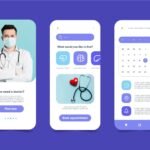Introduction
The healthcare industry is undergoing a major transformation, thanks to advancements in digital technology. One of the most promising innovations is 5G in healthcare, which is set to revolutionize the way medical services are delivered. With its ultra-fast speeds, low latency, and high reliability, 5G technology is enhancing telemedicine, robotic surgeries, remote patient monitoring, and real-time data analytics.
What is 5G in Healthcare?
5G, the fifth generation of mobile network technology, offers faster and more reliable wireless communication. In the healthcare sector, 5G is facilitating real-time data exchange, seamless connectivity, and enhanced remote medical services, making healthcare more accessible, efficient, and innovative.
Key Features of 5G in Healthcare:
- Ultra-Fast Speed: Enables real-time data sharing between medical devices and healthcare providers.
- Low Latency: Reduces delays in critical medical applications like robotic surgeries.
- High Reliability: Ensures stable connections for remote healthcare services.
- Massive Connectivity: Supports a large number of connected medical devices and IoT-based health solutions.
- Enhanced Security: Provides better encryption and data protection for sensitive patient information.
Benefits of 5G in Healthcare
5G is reshaping healthcare by improving efficiency, accessibility, and patient outcomes. Here are some of its key advantages:
1. Enhanced Telemedicine and Remote Consultations
- Enables high-definition video consultations with no buffering or lag.
- Supports real-time diagnostic imaging sharing between doctors and patients.
- Improves rural healthcare access by connecting remote patients with specialists.
2. Real-Time Remote Patient Monitoring
- 5G-powered wearables track heart rate, blood pressure, and glucose levels in real time.
- Enables instant alerts for emergencies like heart attacks or strokes.
- AI-driven predictive analytics help detect potential health risks early.
3. Faster and More Accurate Medical Imaging
- 5G speeds up the transmission of large medical imaging files (e.g., MRI, CT scans).
- AI algorithms analyze images in real-time, leading to quicker diagnoses.
- Cloud-based image storage allows instant access for multiple specialists.
4. Improved Robotic Surgery and AI Integration
- Low latency ensures precise robotic-assisted surgeries with minimal delays.
- Surgeons can perform remote robotic surgeries with real-time control.
- AI-powered robotic assistants enhance surgical precision and patient safety.
5. Smart Hospitals and IoT-Enabled Healthcare
- 5G connects multiple IoT medical devices for real-time patient monitoring.
- Enhances hospital efficiency with automated inventory tracking and smart bed management.
- AI-driven chatbots and virtual assistants streamline patient interactions.
6. Emergency Response and Ambulance Connectivity
- 5G-connected ambulances transmit patient vitals to hospitals in real-time.
- Emergency responders receive live medical guidance via video calls.
- Faster data transfer allows hospitals to prepare for incoming emergencies.
7. AI-Powered Drug Discovery and Genomics
- 5G accelerates genetic research and personalized medicine.
- AI-driven drug discovery reduces time-to-market for new medications.
- Enables secure, real-time collaboration between researchers worldwide.
Challenges of Implementing 5G in Healthcare
Despite its benefits, 5G adoption in health faces several challenges:
1. High Infrastructure Costs
- Implementing 5G networks in hospitals requires significant investment.
- Upgrading medical equipment to support 5G connectivity is expensive.
2. Data Privacy and Cybersecurity Concerns
- Increased connectivity raises risks of cyberattacks on patient data.
- Strong encryption and HIPAA-compliant security measures are essential.
3. Regulatory and Compliance Issues
- Governments need to set standards for 5G healthcare applications.
- Compliance with medical data protection laws is critical.
4. Limited 5G Availability in Rural Areas
- Many rural areas still lack 5G infrastructure.
- Alternative solutions like satellite-based connectivity may be needed.
5. Compatibility with Existing Healthcare Systems
- Integrating 5G with older hospital systems requires significant modifications.
- Upgrading electronic health records (EHRs) and medical software is necessary.
Use Cases of 5G in Healthcare
Here are some real-world applications of 5G in healthcare:
- Remote Surgeries: Surgeons in different locations perform surgeries using 5G-powered robotic arms.
- Smart Ambulances: Paramedics transmit patient data to hospitals in real-time for faster treatment.
- AI-Powered Health Monitoring: Wearables and IoMT (Internet of Medical Things) devices analyze patient vitals.
- 5G-Enabled Smart Hospitals: Automated inventory management, AI-driven diagnostics, and connected patient care.
- Medical Training and Augmented Reality (AR): Medical students use 5G-powered AR simulations for training.
Future Trends in 5G Healthcare Technology
The future of 5G in healthcare will see more innovations, including:
1. AI-Driven Personalized Medicine
- 5G enables faster AI analysis of patient data for customized treatment plans.
2. Blockchain for Healthcare Security
- Blockchain + 5G ensures secure patient data management and fraud prevention.
3. 5G and Augmented Reality (AR) in Healthcare
- AR-powered surgical training and real-time patient diagnosis will become more common.
4. Expansion of 5G Rural Healthcare Services
- 5G will bridge healthcare accessibility gaps in remote areas.
5. Edge Computing for Faster Data Processing
- Medical devices will process data locally, reducing cloud dependency.
Frequently Asked Questions (FAQs)
Q1. How does 5G improve telemedicine?
5G enhances telemedicine by providing high-quality video calls, real-time imaging, and fast medical data transfers, making remote consultations more effective.
Q2. Can 5G be used in robotic surgery?
Yes, 5G’s low latency allows for precise, real-time control in robotic-assisted and remote surgeries.
Q3. How does 5G enhance emergency medical services?
5G enables real-time data sharing between ambulances and hospitals, ensuring doctors are prepared before the patient arrives.
Q4. Is 5G secure for healthcare applications?
5G offers improved security features, but strong encryption and compliance with health regulations are essential to prevent cyber threats.
Q5. What is the future of 5G in healthcare?
The future of 5G in healthcare includes AI-powered diagnostics, blockchain security, AR medical training, and improved rural healthcare access.
Conclusion
The adoption of 5G in healthcare is paving the way for faster, smarter, and more efficient medical services. With benefits like real-time remote monitoring, AI-driven analytics, and advanced robotic surgeries, 5G is set to transform the health landscape. While challenges like high costs, cybersecurity risks, and regulatory hurdles remain, the potential for innovation is immense. As 5G networks continue to expand, the future of digital healthcare will become more connected, intelligent, and patient-centered.






BsjDYqZm RlK ZbRKf lkKn hcbDdQ LPTNYME